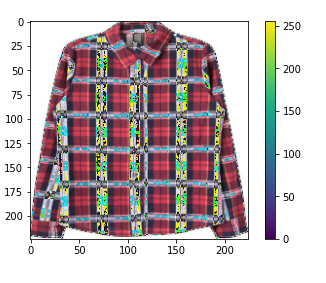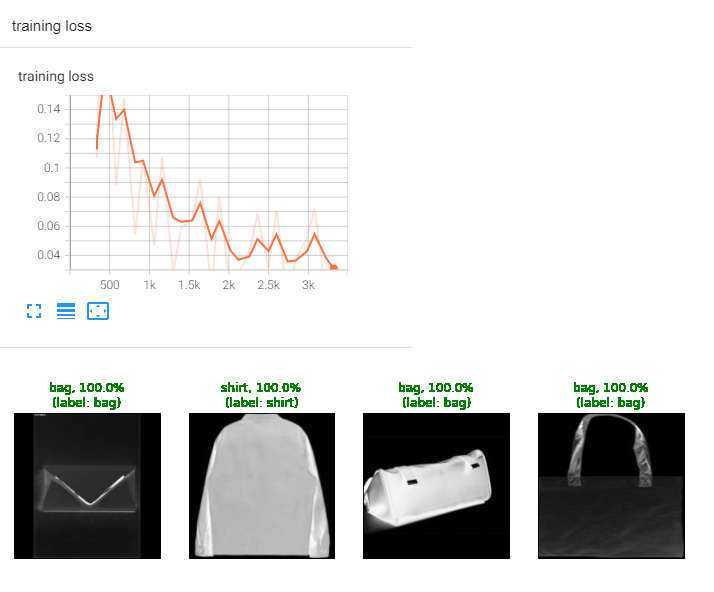概要
Fashionデータを利用してカバン、シャツ、スカートなどイメージを分類しました。
構成
- データパイプライン : データをロードする時に負担を緩和するためにパイプライン構築
- 早めに学習終了設定 : 学習改善があまり進めても出来ない場合は早めに学習終了を設定する。
- TensorBoard設定 : TensorBoardと連結して学習進行状態を見る。
ディレクトリ
以下のようにdatasetディレクトリにバッグ、シャツ、スカートなどフォルダが分かれてるし、画像ファイルがあります。
├─dataset
│ ├─bag
│ ├─shirt
│ └─skirt
└─runs
└─fashion_classification
データをロード
import os
import time
from PIL import Image
import numpy as np
import matplotlib.pyplot as plt
import random
import torch
import torch.nn as nn
from torch import optim, cuda
from torch.utils.data import DataLoader
from torch.utils.tensorboard import SummaryWriter
from torchvision import datasets, models, transforms
from torchvision.utils import make_grid
import matplotlib.pyplot as plt
from torchsummary import summary
BASE_DIR = os.getcwd()
DATASET_PATH = os.path.join(BASE_DIR, 'dataset')
MODE_PATH = os.path.join(BASE_DIR, 'models')
npyファイルをチェックする理由は最初の訓練時はイメージでnpyファイルを生成し次の訓練の時からnpyファイルをロードして時間を節約するため。
classes = []
dataset = []
for fullpath, dirnames, filenames in os.walk(DATASET_PATH):
if DATASET_PATH == fullpath:
classes = dirnames
continue
label_name = fullpath.split(os.path.sep)[-1]
for filename in filenames:
if filename.find('.npy') != -1:
continue
class_index = classes.index(label_name)
dataset.append((os.path.join(fullpath, filename), class_index))
random.shuffle(dataset)
total_len = len(dataset)
train_ratio = int(total_len * 0.8)
train_data = dataset[:train_ratio]
test_data = dataset[train_ratio:]
データパイプライン
すべてのデータを取得してメモリが負荷することがある。そのために訓練時バッチサイズだけ取得してデータを加工する。
最初の訓練時のイメージのパスでnpyファイルを作成し、次の訓練の時からnpyファイルだけをロードして、時間をデータの読み込み時間を節約する。
class Dataset(object):
def __init__(self, transforms, dataset):
self.transforms = transforms
self.dataset = dataset
def __getitem__(self, idx):
img_path, label = self.dataset[idx]
fullpath, extension = os.path.splitext(img_path)
npy_path = fullpath + '.npy'
if os.path.exists(npy_path):
np_data = np.load(npy_path)
img = Image.fromarray(np.uint8(np_data))
else:
img = Image.open(img_path).convert("RGB")
np_data = np.asarray(img)
np.save(npy_path, np_data)
if self.transforms is not None:
img = self.transforms(img)
return img, label
def __len__(self):
return len(self.dataset)
transform = transforms.Compose(
[
transforms.Resize((224, 224)),
transforms.ToTensor(),
transforms.Normalize((0.5, 0.5, 0.5), (0.5, 0.5, 0.5))
]
)
訓練および評価データパイプラインを生成する。
train_dataset = Dataset(transform, train_data)
test_dataset = Dataset(transform, test_data)
train_loader = torch.utils.data.DataLoader(train_dataset, batch_size=20)
test_loader = torch.utils.data.DataLoader(test_dataset, batch_size=5)
データ視覚化
イメージ一つを視覚化して見る。
dataloader = iter(train_loader)
imgs, target = dataloader.next()
tf = transforms.ToPILImage()
pil_img = tf(imgs[0])
plt.figure()
plt.imshow(pil_img)
plt.colorbar()
plt.gca().grid(False)
モデル設定
vgg19モデルを参考。
learning_rate = 0.001
device = torch.device('cuda') if torch.cuda.is_available() else torch.device('cpu')
device
class Net(nn.Module):
def __init__(self):
super(Net, self).__init__()
self.conv = nn.Sequential(
nn.Conv2d(3, 64, 3, padding=1),nn.LeakyReLU(0.2),
nn.Conv2d(64, 64, 3, padding=1),nn.LeakyReLU(0.2),
nn.MaxPool2d(2, 2),
nn.Conv2d(64, 128, 3, padding=1),nn.LeakyReLU(0.2),
nn.Conv2d(128, 128, 3, padding=1),nn.LeakyReLU(0.2),
nn.MaxPool2d(2, 2),
nn.Conv2d(128, 256, 3, padding=1),nn.LeakyReLU(0.2),
nn.Conv2d(256, 256, 3, padding=1),nn.LeakyReLU(0.2),
nn.Conv2d(256, 256, 3, padding=1),nn.LeakyReLU(0.2),
nn.MaxPool2d(2, 2),
nn.Conv2d(256, 512, 3, padding=1),nn.LeakyReLU(0.2),
nn.Conv2d(512, 512, 3, padding=1),nn.LeakyReLU(0.2),
nn.Conv2d(512, 512, 3, padding=1),nn.LeakyReLU(0.2),
nn.MaxPool2d(2, 2),
nn.Conv2d(512, 512, 3, padding=1),nn.LeakyReLU(0.2),
nn.Conv2d(512, 512, 3, padding=1),nn.LeakyReLU(0.2),
nn.Conv2d(512, 512, 3, padding=1),nn.LeakyReLU(0.2),
nn.MaxPool2d(2, 2)
)
self.avg_pool = nn.AvgPool2d(7)
self.classifier = nn.Linear(512, 10)
def forward(self, x):
features = self.conv(x)
x = self.avg_pool(features)
x = x.view(features.size(0), -1)
x = self.classifier(x)
return x, features
model = Net().to(device)
model
Net(
(conv): Sequential(
(0): Conv2d(3, 64, kernel_size=(3, 3), stride=(1, 1), padding=(1, 1))
(1): LeakyReLU(negative_slope=0.2)
(2): Conv2d(64, 64, kernel_size=(3, 3), stride=(1, 1), padding=(1, 1))
(3): LeakyReLU(negative_slope=0.2)
(4): MaxPool2d(kernel_size=2, stride=2, padding=0, dilation=1, ceil_mode=False)
(5): Conv2d(64, 128, kernel_size=(3, 3), stride=(1, 1), padding=(1, 1))
(6): LeakyReLU(negative_slope=0.2)
(7): Conv2d(128, 128, kernel_size=(3, 3), stride=(1, 1), padding=(1, 1))
(8): LeakyReLU(negative_slope=0.2)
(9): MaxPool2d(kernel_size=2, stride=2, padding=0, dilation=1, ceil_mode=False)
(10): Conv2d(128, 256, kernel_size=(3, 3), stride=(1, 1), padding=(1, 1))
(11): LeakyReLU(negative_slope=0.2)
(12): Conv2d(256, 256, kernel_size=(3, 3), stride=(1, 1), padding=(1, 1))
(13): LeakyReLU(negative_slope=0.2)
(14): Conv2d(256, 256, kernel_size=(3, 3), stride=(1, 1), padding=(1, 1))
(15): LeakyReLU(negative_slope=0.2)
(16): MaxPool2d(kernel_size=2, stride=2, padding=0, dilation=1, ceil_mode=False)
(17): Conv2d(256, 512, kernel_size=(3, 3), stride=(1, 1), padding=(1, 1))
(18): LeakyReLU(negative_slope=0.2)
(19): Conv2d(512, 512, kernel_size=(3, 3), stride=(1, 1), padding=(1, 1))
(20): LeakyReLU(negative_slope=0.2)
(21): Conv2d(512, 512, kernel_size=(3, 3), stride=(1, 1), padding=(1, 1))
(22): LeakyReLU(negative_slope=0.2)
(23): MaxPool2d(kernel_size=2, stride=2, padding=0, dilation=1, ceil_mode=False)
(24): Conv2d(512, 512, kernel_size=(3, 3), stride=(1, 1), padding=(1, 1))
(25): LeakyReLU(negative_slope=0.2)
(26): Conv2d(512, 512, kernel_size=(3, 3), stride=(1, 1), padding=(1, 1))
(27): LeakyReLU(negative_slope=0.2)
(28): Conv2d(512, 512, kernel_size=(3, 3), stride=(1, 1), padding=(1, 1))
(29): LeakyReLU(negative_slope=0.2)
(30): MaxPool2d(kernel_size=2, stride=2, padding=0, dilation=1, ceil_mode=False)
)
(avg_pool): AvgPool2d(kernel_size=7, stride=7, padding=0)
(classifier): Linear(in_features=512, out_features=10, bias=True)
)
criterion = torch.nn.CrossEntropyLoss().to(device)
optimizer = torch.optim.Adam(model.parameters(), lr=learning_rate)
summary(model.to(device), (3, 224, 224))
----------------------------------------------------------------
Layer (type) Output Shape Param #
================================================================
Conv2d-1 [-1, 64, 224, 224] 1,792
LeakyReLU-2 [-1, 64, 224, 224] 0
Conv2d-3 [-1, 64, 224, 224] 36,928
LeakyReLU-4 [-1, 64, 224, 224] 0
MaxPool2d-5 [-1, 64, 112, 112] 0
Conv2d-6 [-1, 128, 112, 112] 73,856
LeakyReLU-7 [-1, 128, 112, 112] 0
Conv2d-8 [-1, 128, 112, 112] 147,584
LeakyReLU-9 [-1, 128, 112, 112] 0
MaxPool2d-10 [-1, 128, 56, 56] 0
Conv2d-11 [-1, 256, 56, 56] 295,168
LeakyReLU-12 [-1, 256, 56, 56] 0
Conv2d-13 [-1, 256, 56, 56] 590,080
LeakyReLU-14 [-1, 256, 56, 56] 0
Conv2d-15 [-1, 256, 56, 56] 590,080
LeakyReLU-16 [-1, 256, 56, 56] 0
MaxPool2d-17 [-1, 256, 28, 28] 0
Conv2d-18 [-1, 512, 28, 28] 1,180,160
LeakyReLU-19 [-1, 512, 28, 28] 0
Conv2d-20 [-1, 512, 28, 28] 2,359,808
LeakyReLU-21 [-1, 512, 28, 28] 0
Conv2d-22 [-1, 512, 28, 28] 2,359,808
LeakyReLU-23 [-1, 512, 28, 28] 0
MaxPool2d-24 [-1, 512, 14, 14] 0
Conv2d-25 [-1, 512, 14, 14] 2,359,808
LeakyReLU-26 [-1, 512, 14, 14] 0
Conv2d-27 [-1, 512, 14, 14] 2,359,808
LeakyReLU-28 [-1, 512, 14, 14] 0
Conv2d-29 [-1, 512, 14, 14] 2,359,808
LeakyReLU-30 [-1, 512, 14, 14] 0
MaxPool2d-31 [-1, 512, 7, 7] 0
AvgPool2d-32 [-1, 512, 1, 1] 0
Linear-33 [-1, 10] 5,130
================================================================
Total params: 14,719,818
Trainable params: 14,719,818
Non-trainable params: 0
----------------------------------------------------------------
Input size (MB): 0.57
Forward/backward pass size (MB): 218.40
Params size (MB): 56.15
Estimated Total Size (MB): 275.12
----------------------------------------------------------------
class EarlyStopping:
"""Early stops the training if validation loss doesn't improve after a given patience."""
def __init__(self, patience=10, verbose=False, delta=0, path='checkpoint.pt', trace_func=print):
"""
Args:
patience (int): How long to wait after last time validation loss improved.
Default: 7
verbose (bool): If True, prints a message for each validation loss improvement.
Default: False
delta (float): Minimum change in the monitored quantity to qualify as an improvement.
Default: 0
path (str): Path for the checkpoint to be saved to.
Default: 'checkpoint.pt'
trace_func (function): trace print function.
Default: print
"""
self.patience = patience
self.verbose = verbose
self.counter = 0
self.best_score = None
self.early_stop = False
self.val_loss_min = np.Inf
self.delta = delta
self.path = path
self.trace_func = trace_func
def __call__(self, val_loss, model):
score = -val_loss
if self.best_score is None:
self.best_score = score
self.save_checkpoint(val_loss, model)
elif score < self.best_score + self.delta:
self.counter += 1
self.trace_func(f'EarlyStopping counter: {self.counter} out of {self.patience}')
if self.counter >= self.patience:
self.early_stop = True
else:
self.best_score = score
self.save_checkpoint(val_loss, model)
self.counter = 0
def save_checkpoint(self, val_loss, model):
'''Saves model when validation loss decrease.'''
if self.verbose:
self.trace_func(f'Validation loss decreased ({self.val_loss_min:.6f} --> {val_loss:.6f}). Saving model ...')
torch.save(model.state_dict(), self.path)
self.val_loss_min = val_loss
writer = SummaryWriter('runs/fashion_classification')
def matplotlib_imshow(img, one_channel=False):
if one_channel:
img = img.mean(dim=0)
img = img / 2 + 0.5
npimg = img.cpu().numpy()
if one_channel:
plt.imshow(npimg, cmap="Greys")
else:
plt.imshow(np.transpose(npimg, (1, 2, 0)))
def images_to_probs(model, images):
output,f = model(images)
_, preds_tensor = torch.max(output, 1)
preds = np.squeeze(preds_tensor.cpu().numpy())
return preds, [nn.functional.softmax(el, dim=0)[i].item() for i, el in zip(preds, output)]
def plot_classes_preds(model, images, labels):
preds, probs = images_to_probs(model, images)
fig = plt.figure(figsize=(12, 48))
for idx in np.arange(4):
if len(images) - 1 < idx:
break
ax = fig.add_subplot(1, 4, idx+1, xticks=[], yticks=[])
matplotlib_imshow(images[idx], one_channel=True)
ax.set_title("{0}, {1:.1f}%\n(label: {2})".format(
classes[preds[idx]],
probs[idx] * 100.0,
classes[labels[idx]]), color=("green" if preds[idx]==labels[idx].item() else "red"))
return fig
学習(訓練)
def train_model(model, n_epochs):
train_losses = []
valid_losses = []
early_stopping = EarlyStopping(verbose = True)
for epoch in range(n_epochs):
epoch_loss = 0
start = time.time()
model.train()
for batch, (data, target) in enumerate(train_loader, 1):
data = data.to(device)
target = target.to(device)
output, f = model(data)
loss = criterion(output, target)
optimizer.zero_grad()
loss.backward()
optimizer.step()
epoch_loss += loss
if batch % 100 == 0:
writer.add_scalar('training loss', epoch_loss / 100, epoch * len(train_loader) + batch)
writer.add_figure('predictions vs. actuals', plot_classes_preds(model, data, target), global_step=epoch * len(train_loader) + batch)
print(f'epoch : {epoch+1}, Loss : {epoch_loss}, time : {time.time() - start}')
model.eval()
for data, target in test_loader :
data = data.to(device)
target = target.to(device)
output, f = model(data)
loss = criterion(output, target)
valid_losses.append(loss.item())
train_loss = np.average(train_losses)
valid_loss = np.average(valid_losses)
epoch_len = len(str(n_epochs))
train_losses = []
valid_losses = []
early_stopping(valid_loss, model)
if early_stopping.early_stop:
print("Early stopping")
break
n_epochs = 50
train_model(model, n_epochs)
Tensorboard観察
tensorboard --logdir runs
予測
columns = 5
rows = 3
fig = plt.figure(figsize=(20,10))
model.eval()
for i in range(1, columns*rows+1):
idx = np.random.randint(len(test_data))
img_path, class_index = test_data[idx]
pil_img = Image.open(img_path).convert('RGB')
img = transform(pil_img).unsqueeze(dim=0).to(device)
output,f = model(img)
_, argmax = torch.max(output, 1)
pred = classes[argmax.item()]
label = classes[class_index]
fig.add_subplot(rows, columns, i)
plt.title(pred)
plt.imshow(pil_img)
plt.axis('off')
plt.show()


